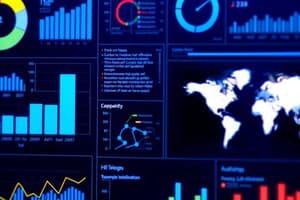Podcast
Questions and Answers
What is the primary goal of the cleaning phase in data wrangling?
What is the primary goal of the cleaning phase in data wrangling?
- To validate the data integrity
- To merge different datasets
- To restructure the data format
- To enhance data accuracy (correct)
During which phase of data preprocessing is categorical data converted into a numerical format?
During which phase of data preprocessing is categorical data converted into a numerical format?
- Data Validation
- Encoding (correct)
- Handling Missing Values
- Scaling/Normalization
Which activity is part of structuring data during the data wrangling process?
Which activity is part of structuring data during the data wrangling process?
- Removing duplicates
- Converting data types (correct)
- Merging datasets
- Documenting data lineage
What does the validation step ensure in the data wrangling process?
What does the validation step ensure in the data wrangling process?
What is the purpose of scaling or normalization in data preprocessing?
What is the purpose of scaling or normalization in data preprocessing?
What is the primary focus of data science?
What is the primary focus of data science?
Why is Python preferred for financial data analysis?
Why is Python preferred for financial data analysis?
Which aspect of data science is critical for decision-making in finance?
Which aspect of data science is critical for decision-making in finance?
What is one way data science contributes to fraud prevention?
What is one way data science contributes to fraud prevention?
What is data wrangling also known as?
What is data wrangling also known as?
In which area is predictive analysis useful according to the content?
In which area is predictive analysis useful according to the content?
What benefit does customer analytics provide in finance?
What benefit does customer analytics provide in finance?
What is one application of data science in revenue forecasting?
What is one application of data science in revenue forecasting?
Study Notes
What is Data Science?
- Data science is the study of data for meaningful business insights
- It encompasses data gathering, analysis, and decision-making
- Key goals: finding patterns in data, making predictions, and discovering hidden information
- Data Science enables companies to make better decisions, perform predictive analysis, and discover patterns in their data
Where is Data Science Needed?
- Data Science is used across various industries like banking, consultancy, healthcare, and manufacturing.
- It’s valuable in route planning, forecasting delays, creating promotions, optimizing delivery timing, forecasting revenue, analyzing training benefits, and predicting election outcomes.
What is data science used for in finance?
- Data science in Finance helps improve decision-making, reduce risk, and increase efficiency.
- Key Applications:
- Fraud detection and prevention
- Credit allocation
- Risk management and analysis
- Customer analytics and segmentation
- Pricing optimization
Python for Financial Data Analysis
- Python is the predominant programming language in finance.
- It’s object-oriented and open-source, utilized by numerous corporations including Google.
- Python imports financial data, such as stock quotes, using the Pandas framework.
What is Data Wrangling?
- Data wrangling cleans, structures, and transforms raw data into a usable format for analysis.
- This includes handling missing or inconsistent data, formatting data types, and merging different datasets.
Data Wrangling Steps:
- Discover: Identifying data sources, assessing data quality, and analyzing data structure and format.
- Structure: Reshaping, handling missing values, and converting data types.
- Clean: Removing or correcting inaccurate data, handling duplicates, and addressing anomalies impacting data reliability.
- Enrich: Merging datasets, extracting relevant features, or incorporating external data sources.
- Validate: Ensuring data quality and reliability.
- Publish: Documenting data lineage, sharing metadata, and preparing data for storage or integration into data science tools.
Data Preprocessing
- A part of data wrangling that focuses on preparing data for analysis and modeling.
- Key tasks:
- Scaling/Normalization: Adjusting numerical data values to a specific range.
- Encoding: Converting categorical data into numerical formats.
- Handling Missing Values: Deciding how to deal with missing data (like removal, filling with averages, or predicting missing data).
- Splitting Data: Dividing data into training and testing sets for machine learning.
Studying That Suits You
Use AI to generate personalized quizzes and flashcards to suit your learning preferences.
Related Documents
Description
This quiz explores the fundamentals of data science and its applications across various industries, especially in finance. Discover how data science drives decision-making, enhances efficiency, and uncovers valuable patterns in business data.





